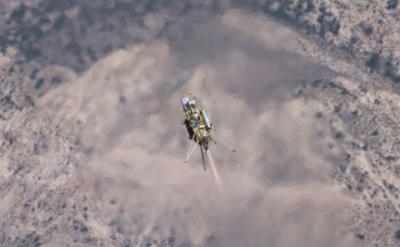Wed, Aug 14, 2013
Flight Control Algorithm Designed To Make Touchdowns More Accurate
A year after NASA's Mars rover Curiosity's landed on Mars, engineers at NASA's Jet Propulsion Laboratory in Pasadena, CA, are testing a sophisticated flight-control algorithm that could allow for even more precise, pinpoint landings of future Martian spacecraft.

Flight testing of the new Fuel Optimal Large Divert Guidance algorithm – G-FOLD for short – for planetary pinpoint landing is being conducted jointly by JPL engineers in cooperation with Masten Space Systems in Mojave, CA, using Masten's XA-0.1B "Xombie" vertical-launch, vertical-landing experimental rocket.
NASA's Space Technology Mission Directorate is facilitating the tests via its Game-Changing Development and Flight Opportunities Programs; the latter managed at NASA's Dryden Flight Research Center at Edwards Air Force Base, CA The two space technology programs work together to test game-changing technologies by taking advantage of Flight Opportunities' commercially provided suborbital platforms and flights.
"The Flight Opportunities Program supports both the development of innovative space technology and the emerging suborbital industry by using commercial suborbital vehicles to test concepts that could further mankind's exploration and understanding of the universe," said Christopher Baker, a campaign manager for the program. "The collaboration between JPL and Masten to test G-FOLD is a great example of how we hope to further the exploration of the solar system while building up the industrial base needed to advance future space endeavors."
Current powered-descent guidance algorithms used for spacecraft landings are inherited from the Apollo era. These algorithms do not optimize fuel usage and significantly limit how far the landing craft can be diverted during descent. The new G-FOLD algorithm invented by JPL autonomously generates fuel-optimal landing trajectories in real time and provides a key new technology required for planetary pinpoint landing. Pinpoint landing capability will allow robotic missions to access currently inaccessible science targets. For crewed missions, it will allow increased precision with minimal fuel requirements to enable landing larger payloads in close proximity to predetermined targets.
Masten Space Systems launched the Xombie July 30 from the company's test pad at the Mojave Air and Space Port. JPL and Masten are planning to conduct a second flight test with a more complicated divert profile in August, pending data analysis.
To simulate a course correction during a Martian entry in the July test, Masten's Xombie was given a vertical descent profile to an incorrect landing point. About 90 feet into the profile, the G-FOLD flight control software was automatically triggered to calculate a new flight profile in real-time, and the rocket was successfully diverted to the "correct" landing point some 2,460 feet away.
"This flight was an unprecedented free-flying demonstration of the on-board calculation of a fuel-optimal trajectory in real time," said Martin Regehr, acting task lead for the Autonomous Descent Ascent Powered-Flight Testbed at JPL.
Masten Space Systems is one of seven suborbital reusable launch companies contracted by NASA's Flight Opportunities Program to fly experiments in sub-orbital space to verify new technologies work as expected in this harsh environment.
(Image provided by NASA)
More News
States That Current Process is Damaging National Aerospace Development US Senator Jerry Morgan is pushing the FAA to speed up the process for rocket launch licensing. He argues tha>[...]
From 2015 (YouTube Edition): Model Aviator Aims For Full-Scale Career While at the 2015 Indoor Electric RC Festival, referred to as eFest, ANN CEO and Editor-In-Chief, Jim Campbell>[...]
Dave Juwel's Aviation Marketing Stories ITBOA BNITBOB ... what does that mean? It's not gibberish, it's a lengthy acronym for "In The Business Of Aviation ... But Not In The Busine>[...]
Aero Linx: Cardinal Flyers Online The Cardinal Flyers Online Web site was created and is maintained by me, Keith Peterson. My wife Debbie and I have owned a 1976 RG since 1985. Wit>[...]
Clearance Void If Not Off By (Time) Used by ATC to advise an aircraft that the departure release is automatically canceled if takeoff is not made prior to a specified time. The exp>[...]
 Senator Pushes FAA to Accelerate Rocket Launch Licensing
Senator Pushes FAA to Accelerate Rocket Launch Licensing Classic Aero-TV: RJ Gritter - Part of Aviations Bright New Future
Classic Aero-TV: RJ Gritter - Part of Aviations Bright New Future Aero-FAQ: Dave Juwel's Aviation Marketing Stories -- ITBOA BNITBOB
Aero-FAQ: Dave Juwel's Aviation Marketing Stories -- ITBOA BNITBOB ANN's Daily Aero-Linx (10.27.24)
ANN's Daily Aero-Linx (10.27.24) ANN's Daily Aero-Term (10.27.24): Clearance Void If Not Off By (Time)
ANN's Daily Aero-Term (10.27.24): Clearance Void If Not Off By (Time)



